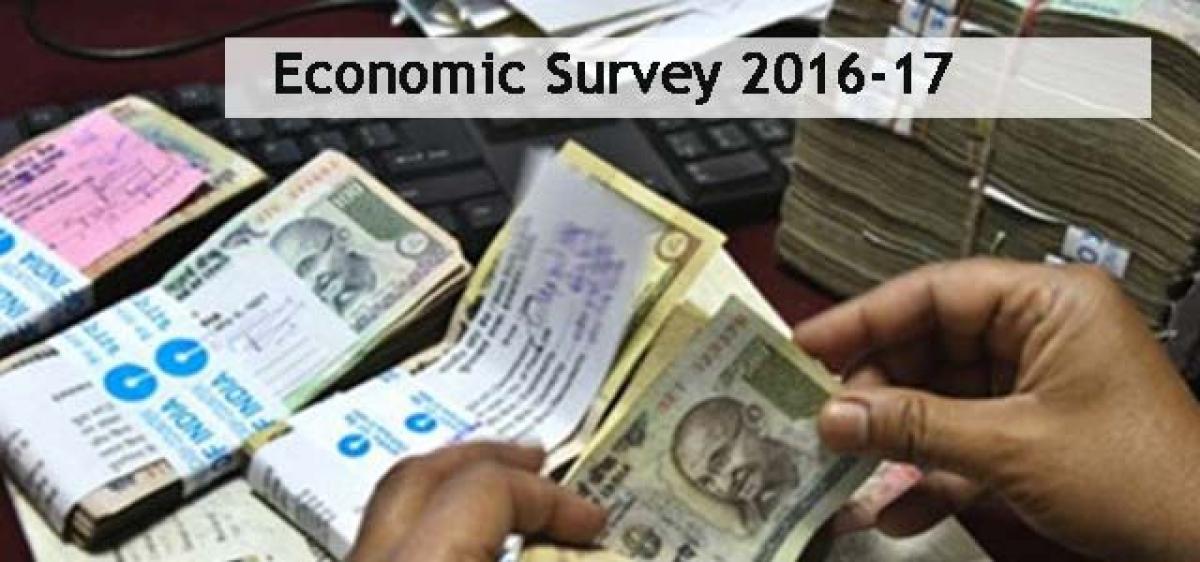Live
- Pokémon TCG Pocket to Introduce Card Trading in January 2025
- Nani unveils ‘MM 2’ title & first look
- Will challenge bail granted to actor Darshan in fan murder case in SC: Bengaluru Police Commissioner
- Chandrahass Launches Maruti Suzuki Dzire Through PJ Productions in Tolichowki Showroom
- Police case against farmers for tilling land claimed by Waqf Board in Karnataka
- Commendable move: Sandeep Dikshit on renaming Sarai Kale Khan ISBT chowk after Birsa Munda
- MahaYuti will come back to power with a thumping majority despite Oppn's tirade: Eknath Shinde
- ‘Hanging up my racquet. Thank you’ - India’s Prajnesh Gunneswaran retires from professional tennis
- Pawan Kalyan to Campaign for NDA Alliance in Maharashtra
- Eight killed, five injured in Nepal's traffic accident
Just In

The Economic Survey 2016-17 has highlighted the need for fiscal prudence both by the Centre as well as the States in order to maintain overall fiscal health of the economy. It states that the Centre’s Fiscal Responsibility and Budget Management (FRBM) Act, was mirrored by Fiscal Responsibility Legislations (FRL) adopted in the States.
Good fiscal performance by States should be incentivized to keep the overall fiscal performance on track
The Economic Survey 2016-17 has highlighted the need for fiscal prudence both by the Centre as well as the States in order to maintain overall fiscal health of the economy. It states that the Centre’s Fiscal Responsibility and Budget Management (FRBM) Act, was mirrored by Fiscal Responsibility Legislations (FRL) adopted in the States.
As per the Economic Survey, there has been an improvement in the financial position of the States over the last few years. The average revenue deficit has been eliminated, while the average fiscal deficit was curbed to less than 3 per cent of GSDP. The average debt to GSDP ratio has also fallen.
However, just because fiscal progress followed the introduction of the FRL, it doesn’t mean that the progress can be attributed entirely to FRLs. The following points are important with respect to the improvement in fiscal variables:
I.The deficit reduction owes much to favorable exogenous factors (see Figure 1):
- An acceleration of nominal GDP growth (of 6 percentage points on average after 2005) helped boost States’ revenues by about 1 percent of GSDP;
- Increased transfers from the centre of about 1 percent of GSDP both because of the 13th Finance Commission recommendations and the surge in central government revenues;
- Reduced interest payments of about 0.9 percent of GSDP on account of the debt restructuring package offered by the Centre; and
- Reduced need for spending by the States—estimated at about 1.2 percent of GDP--as the Centre took on a number of major social sector expenditures under the Centrally Sponsored Schemes (CSS).
Figure 1: Decomposition of Reduction in Fiscal, Primary and Revenue Deficit before and after States’ FRL
I.Desisting from splurging rather than belt-tightening was probably the real contribution of the States. Despite the revenue surge, non interest revenue expenditure rose by only 0.4 percent of GSDP.
II.Off-budget expenditures fell, as measured by the flow of explicit guarantees and loans to public utilities fell.
III. There was a sharp drop in the magnitude of forecast errors suggesting an improvement in the process of budget formation. The shortfalls between budgeted and actual own tax revenue went from an average of 5.9 percent of actuals (optimistic forecasts) before the FRL to -0.6 percent of actuals after.
IV. All of these positive indicators show signs of decay in later years; fiscal deficits for example are close the limit of 3 percent on average 10 years after the FRL (see Figure 2).
Figure 2: Average Fiscal Deficit of States in Years Relative to Adoption of FRL (as percent of GSDP)
Economic Survey 2016-17 elaborates that as the fiscal challenges mount for the states because of the Pay Commission recommendations, and mounting payments from the UDAY bonds, there is a need to review how fiscal performance can be kept on track.
Greater reliance will need to be placed on incentivizing good fiscal performance, not least because states are gradually repaying their obligations to the Centre, removing its ability to impose a hard budget constraint on them says the Economic Survey. Above all, however, incentivizing good performance by the States will require the Centre to be an exemplar of sound fiscal management itself.

© 2024 Hyderabad Media House Limited/The Hans India. All rights reserved. Powered by hocalwire.com







